Ford Motor Company: Global Strategy and CSR Analysis Report
VerifiedAdded on 2023/01/19
|18
|2775
|23
Report
AI Summary
This report provides a comprehensive analysis of Ford Motor Company's global business strategies. It examines the company's I-R model, which highlights its approach to balancing local responsiveness and international integration through a transnational strategy. The report delves into Ford's organizational structure, including its HQ-subsidiary dynamics and the use of joint ventures, particularly in China. It explores Ford's strategic alliances in Russia and India, highlighting their restructuring efforts and partnerships with Mahindra. Additionally, the report examines Ford's corporate social responsibility (CSR) initiatives, including the Ford Motor Company Fund, disaster relief programs, and educational programs. The analysis covers Ford's management structure, merging strategies, and its commitment to fuel-efficient and environmentally friendly vehicles. The report also includes an overview of Ford's curriculum programs and leadership initiatives, providing insights into the company's approach to global market segmentation and its efforts to adapt to evolving market needs. The document is contributed by a student to be published on the website Desklib. Desklib is a platform which provides all the necessary AI based study tools for students.

FORD 1
FORD
Name
Course
Tutor
University
City/State
Date
FORD
Name
Course
Tutor
University
City/State
Date
Paraphrase This Document
Need a fresh take? Get an instant paraphrase of this document with our AI Paraphraser
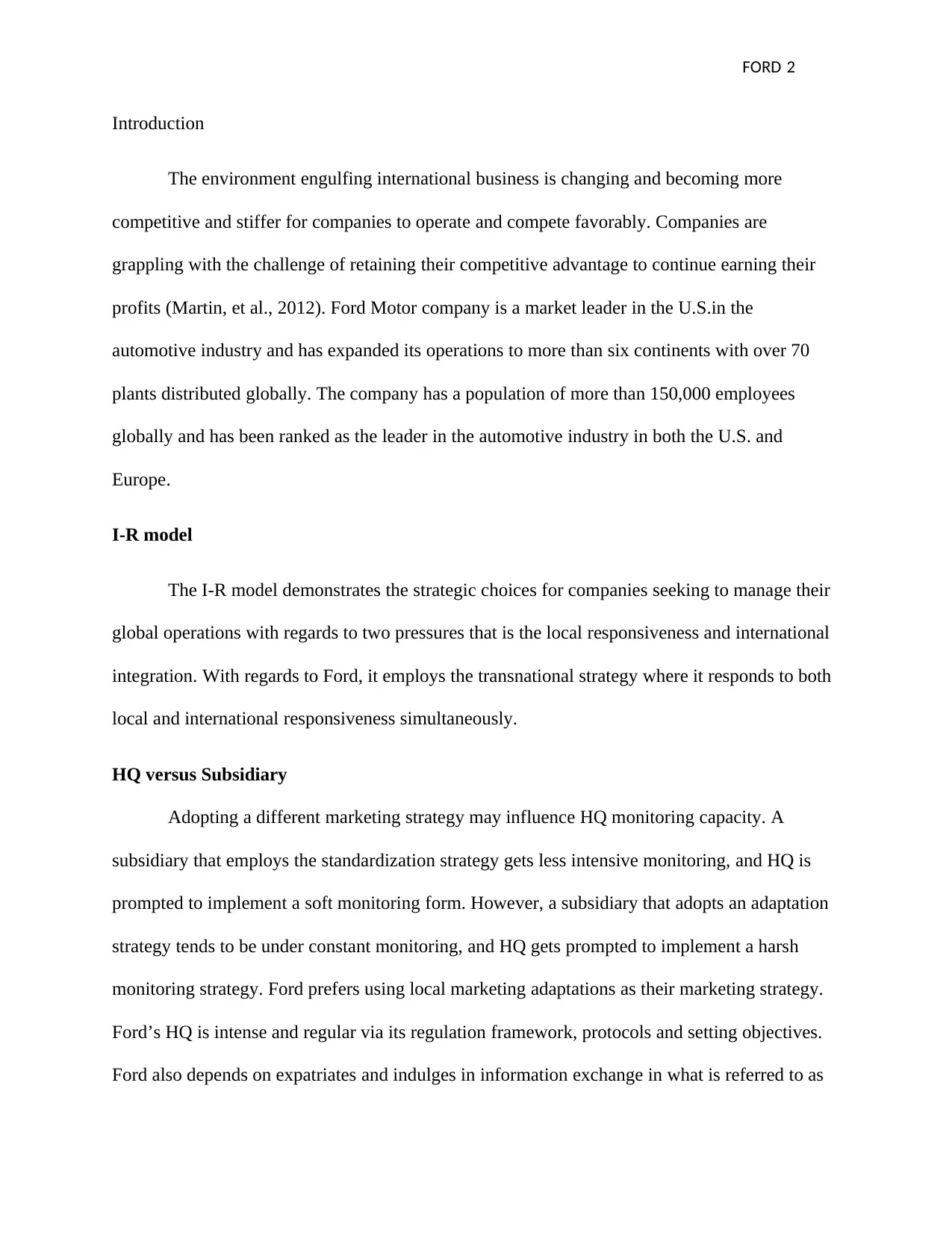
FORD 2
Introduction
The environment engulfing international business is changing and becoming more
competitive and stiffer for companies to operate and compete favorably. Companies are
grappling with the challenge of retaining their competitive advantage to continue earning their
profits (Martin, et al., 2012). Ford Motor company is a market leader in the U.S.in the
automotive industry and has expanded its operations to more than six continents with over 70
plants distributed globally. The company has a population of more than 150,000 employees
globally and has been ranked as the leader in the automotive industry in both the U.S. and
Europe.
I-R model
The I-R model demonstrates the strategic choices for companies seeking to manage their
global operations with regards to two pressures that is the local responsiveness and international
integration. With regards to Ford, it employs the transnational strategy where it responds to both
local and international responsiveness simultaneously.
HQ versus Subsidiary
Adopting a different marketing strategy may influence HQ monitoring capacity. A
subsidiary that employs the standardization strategy gets less intensive monitoring, and HQ is
prompted to implement a soft monitoring form. However, a subsidiary that adopts an adaptation
strategy tends to be under constant monitoring, and HQ gets prompted to implement a harsh
monitoring strategy. Ford prefers using local marketing adaptations as their marketing strategy.
Ford’s HQ is intense and regular via its regulation framework, protocols and setting objectives.
Ford also depends on expatriates and indulges in information exchange in what is referred to as
Introduction
The environment engulfing international business is changing and becoming more
competitive and stiffer for companies to operate and compete favorably. Companies are
grappling with the challenge of retaining their competitive advantage to continue earning their
profits (Martin, et al., 2012). Ford Motor company is a market leader in the U.S.in the
automotive industry and has expanded its operations to more than six continents with over 70
plants distributed globally. The company has a population of more than 150,000 employees
globally and has been ranked as the leader in the automotive industry in both the U.S. and
Europe.
I-R model
The I-R model demonstrates the strategic choices for companies seeking to manage their
global operations with regards to two pressures that is the local responsiveness and international
integration. With regards to Ford, it employs the transnational strategy where it responds to both
local and international responsiveness simultaneously.
HQ versus Subsidiary
Adopting a different marketing strategy may influence HQ monitoring capacity. A
subsidiary that employs the standardization strategy gets less intensive monitoring, and HQ is
prompted to implement a soft monitoring form. However, a subsidiary that adopts an adaptation
strategy tends to be under constant monitoring, and HQ gets prompted to implement a harsh
monitoring strategy. Ford prefers using local marketing adaptations as their marketing strategy.
Ford’s HQ is intense and regular via its regulation framework, protocols and setting objectives.
Ford also depends on expatriates and indulges in information exchange in what is referred to as
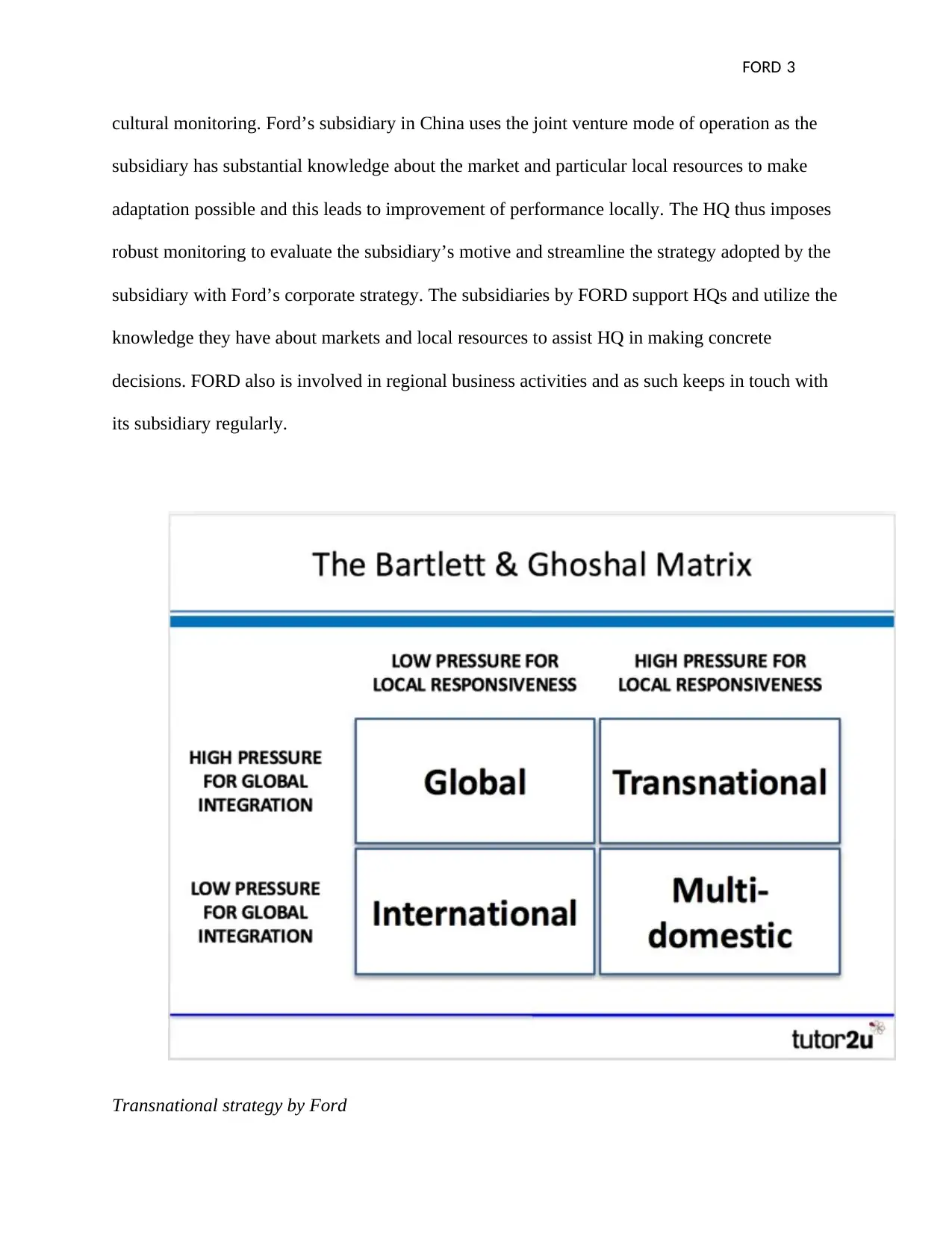
FORD 3
cultural monitoring. Ford’s subsidiary in China uses the joint venture mode of operation as the
subsidiary has substantial knowledge about the market and particular local resources to make
adaptation possible and this leads to improvement of performance locally. The HQ thus imposes
robust monitoring to evaluate the subsidiary’s motive and streamline the strategy adopted by the
subsidiary with Ford’s corporate strategy. The subsidiaries by FORD support HQs and utilize the
knowledge they have about markets and local resources to assist HQ in making concrete
decisions. FORD also is involved in regional business activities and as such keeps in touch with
its subsidiary regularly.
Transnational strategy by Ford
cultural monitoring. Ford’s subsidiary in China uses the joint venture mode of operation as the
subsidiary has substantial knowledge about the market and particular local resources to make
adaptation possible and this leads to improvement of performance locally. The HQ thus imposes
robust monitoring to evaluate the subsidiary’s motive and streamline the strategy adopted by the
subsidiary with Ford’s corporate strategy. The subsidiaries by FORD support HQs and utilize the
knowledge they have about markets and local resources to assist HQ in making concrete
decisions. FORD also is involved in regional business activities and as such keeps in touch with
its subsidiary regularly.
Transnational strategy by Ford
⊘ This is a preview!⊘
Do you want full access?
Subscribe today to unlock all pages.

Trusted by 1+ million students worldwide
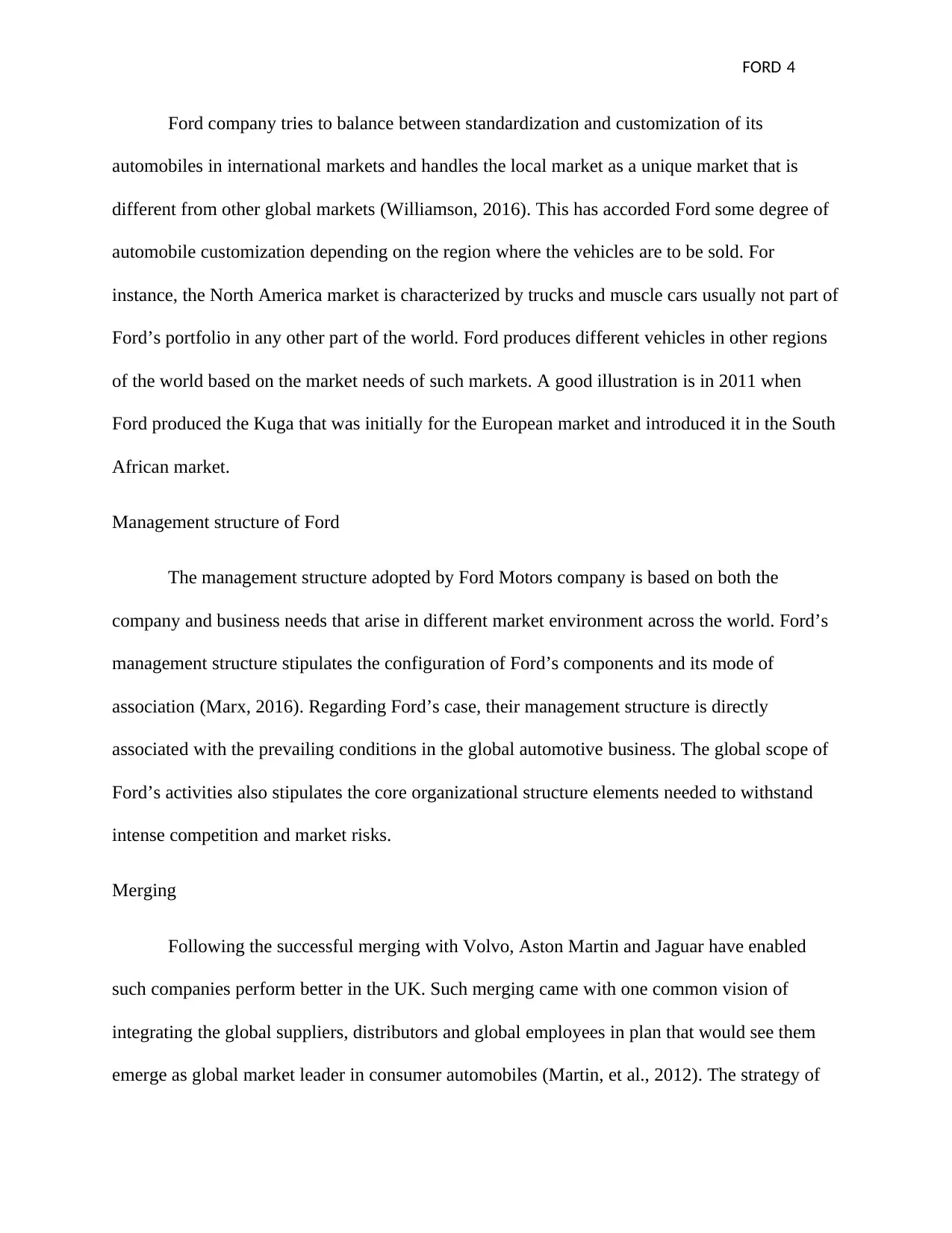
FORD 4
Ford company tries to balance between standardization and customization of its
automobiles in international markets and handles the local market as a unique market that is
different from other global markets (Williamson, 2016). This has accorded Ford some degree of
automobile customization depending on the region where the vehicles are to be sold. For
instance, the North America market is characterized by trucks and muscle cars usually not part of
Ford’s portfolio in any other part of the world. Ford produces different vehicles in other regions
of the world based on the market needs of such markets. A good illustration is in 2011 when
Ford produced the Kuga that was initially for the European market and introduced it in the South
African market.
Management structure of Ford
The management structure adopted by Ford Motors company is based on both the
company and business needs that arise in different market environment across the world. Ford’s
management structure stipulates the configuration of Ford’s components and its mode of
association (Marx, 2016). Regarding Ford’s case, their management structure is directly
associated with the prevailing conditions in the global automotive business. The global scope of
Ford’s activities also stipulates the core organizational structure elements needed to withstand
intense competition and market risks.
Merging
Following the successful merging with Volvo, Aston Martin and Jaguar have enabled
such companies perform better in the UK. Such merging came with one common vision of
integrating the global suppliers, distributors and global employees in plan that would see them
emerge as global market leader in consumer automobiles (Martin, et al., 2012). The strategy of
Ford company tries to balance between standardization and customization of its
automobiles in international markets and handles the local market as a unique market that is
different from other global markets (Williamson, 2016). This has accorded Ford some degree of
automobile customization depending on the region where the vehicles are to be sold. For
instance, the North America market is characterized by trucks and muscle cars usually not part of
Ford’s portfolio in any other part of the world. Ford produces different vehicles in other regions
of the world based on the market needs of such markets. A good illustration is in 2011 when
Ford produced the Kuga that was initially for the European market and introduced it in the South
African market.
Management structure of Ford
The management structure adopted by Ford Motors company is based on both the
company and business needs that arise in different market environment across the world. Ford’s
management structure stipulates the configuration of Ford’s components and its mode of
association (Marx, 2016). Regarding Ford’s case, their management structure is directly
associated with the prevailing conditions in the global automotive business. The global scope of
Ford’s activities also stipulates the core organizational structure elements needed to withstand
intense competition and market risks.
Merging
Following the successful merging with Volvo, Aston Martin and Jaguar have enabled
such companies perform better in the UK. Such merging came with one common vision of
integrating the global suppliers, distributors and global employees in plan that would see them
emerge as global market leader in consumer automobiles (Martin, et al., 2012). The strategy of
Paraphrase This Document
Need a fresh take? Get an instant paraphrase of this document with our AI Paraphraser
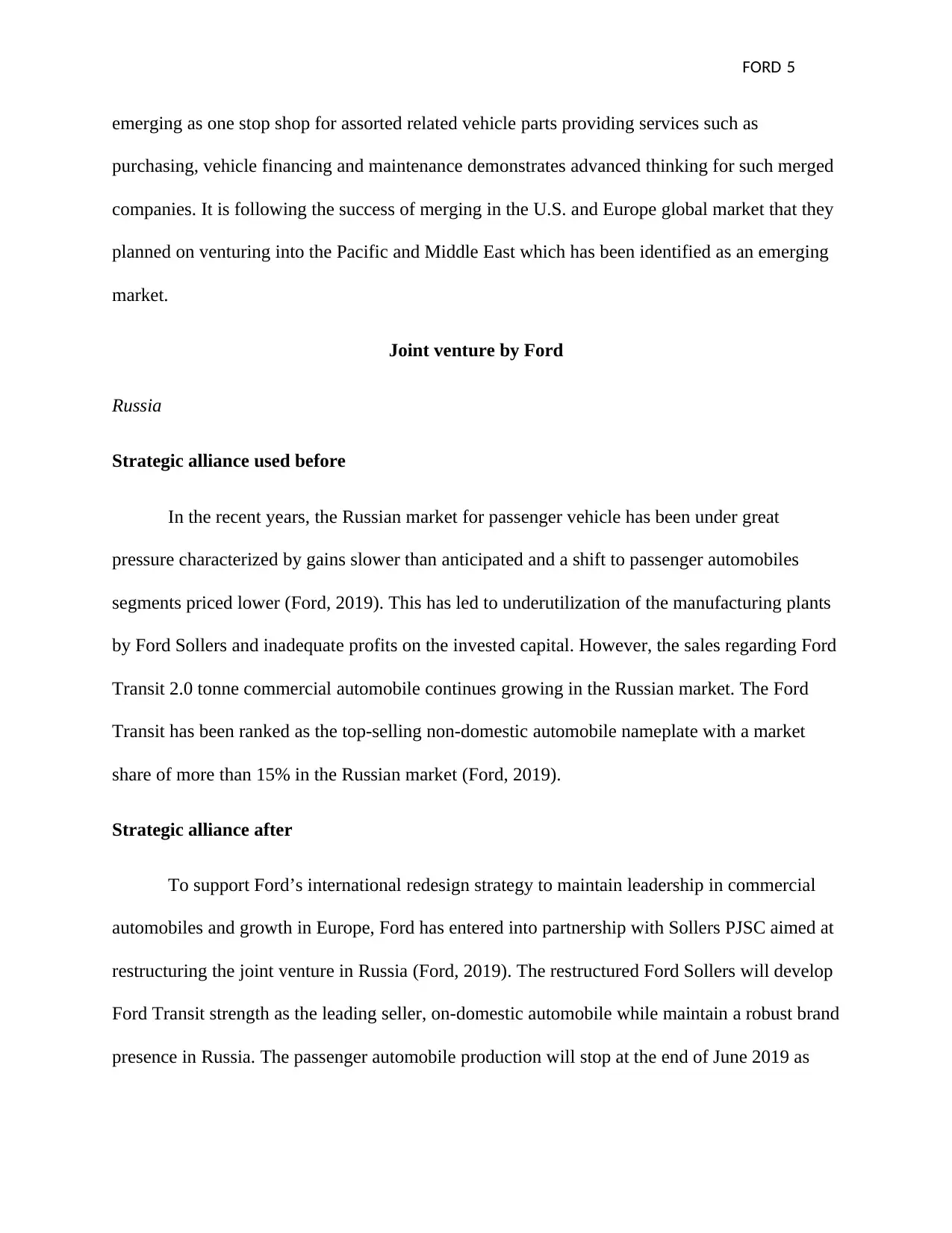
FORD 5
emerging as one stop shop for assorted related vehicle parts providing services such as
purchasing, vehicle financing and maintenance demonstrates advanced thinking for such merged
companies. It is following the success of merging in the U.S. and Europe global market that they
planned on venturing into the Pacific and Middle East which has been identified as an emerging
market.
Joint venture by Ford
Russia
Strategic alliance used before
In the recent years, the Russian market for passenger vehicle has been under great
pressure characterized by gains slower than anticipated and a shift to passenger automobiles
segments priced lower (Ford, 2019). This has led to underutilization of the manufacturing plants
by Ford Sollers and inadequate profits on the invested capital. However, the sales regarding Ford
Transit 2.0 tonne commercial automobile continues growing in the Russian market. The Ford
Transit has been ranked as the top-selling non-domestic automobile nameplate with a market
share of more than 15% in the Russian market (Ford, 2019).
Strategic alliance after
To support Ford’s international redesign strategy to maintain leadership in commercial
automobiles and growth in Europe, Ford has entered into partnership with Sollers PJSC aimed at
restructuring the joint venture in Russia (Ford, 2019). The restructured Ford Sollers will develop
Ford Transit strength as the leading seller, on-domestic automobile while maintain a robust brand
presence in Russia. The passenger automobile production will stop at the end of June 2019 as
emerging as one stop shop for assorted related vehicle parts providing services such as
purchasing, vehicle financing and maintenance demonstrates advanced thinking for such merged
companies. It is following the success of merging in the U.S. and Europe global market that they
planned on venturing into the Pacific and Middle East which has been identified as an emerging
market.
Joint venture by Ford
Russia
Strategic alliance used before
In the recent years, the Russian market for passenger vehicle has been under great
pressure characterized by gains slower than anticipated and a shift to passenger automobiles
segments priced lower (Ford, 2019). This has led to underutilization of the manufacturing plants
by Ford Sollers and inadequate profits on the invested capital. However, the sales regarding Ford
Transit 2.0 tonne commercial automobile continues growing in the Russian market. The Ford
Transit has been ranked as the top-selling non-domestic automobile nameplate with a market
share of more than 15% in the Russian market (Ford, 2019).
Strategic alliance after
To support Ford’s international redesign strategy to maintain leadership in commercial
automobiles and growth in Europe, Ford has entered into partnership with Sollers PJSC aimed at
restructuring the joint venture in Russia (Ford, 2019). The restructured Ford Sollers will develop
Ford Transit strength as the leading seller, on-domestic automobile while maintain a robust brand
presence in Russia. The passenger automobile production will stop at the end of June 2019 as
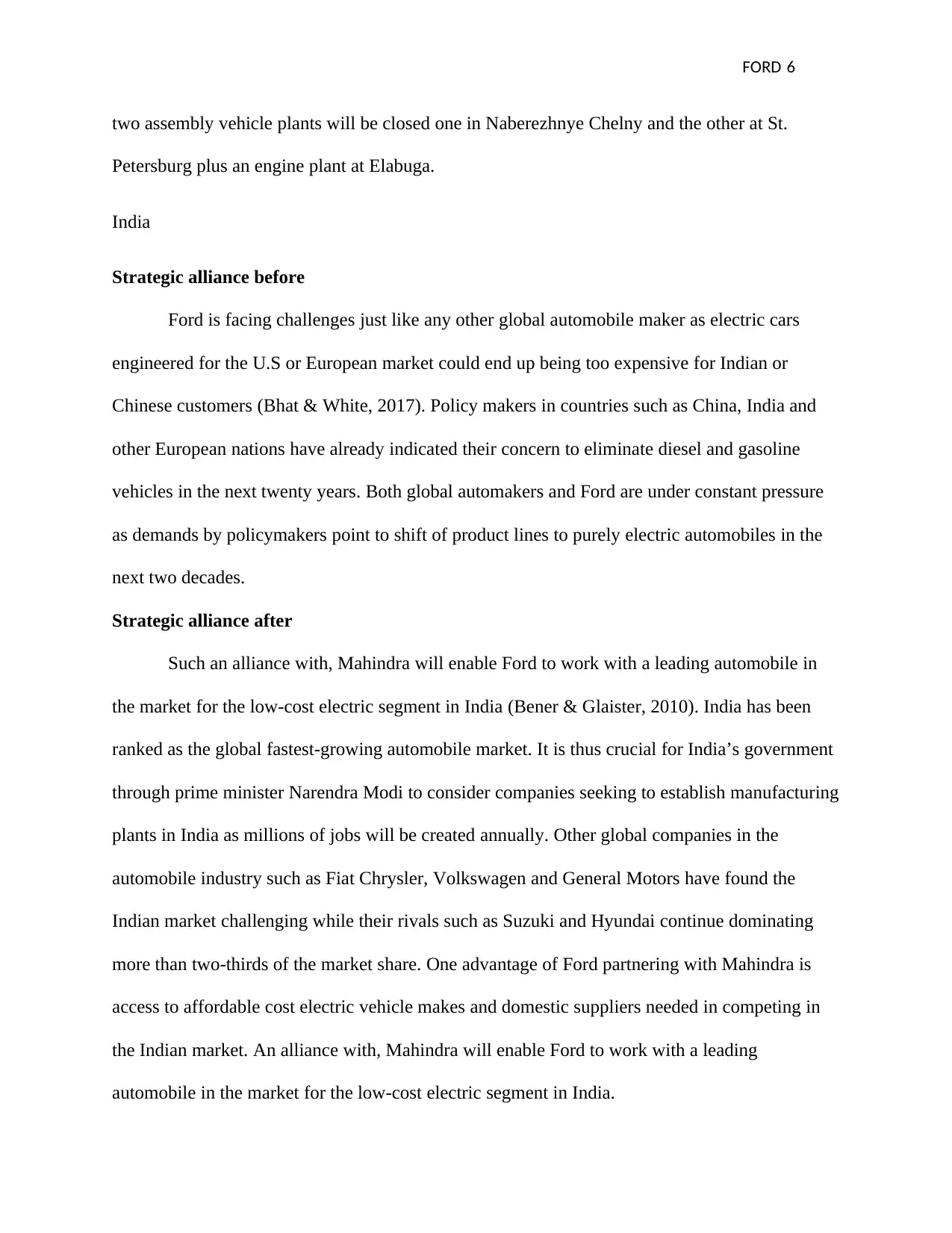
FORD 6
two assembly vehicle plants will be closed one in Naberezhnye Chelny and the other at St.
Petersburg plus an engine plant at Elabuga.
India
Strategic alliance before
Ford is facing challenges just like any other global automobile maker as electric cars
engineered for the U.S or European market could end up being too expensive for Indian or
Chinese customers (Bhat & White, 2017). Policy makers in countries such as China, India and
other European nations have already indicated their concern to eliminate diesel and gasoline
vehicles in the next twenty years. Both global automakers and Ford are under constant pressure
as demands by policymakers point to shift of product lines to purely electric automobiles in the
next two decades.
Strategic alliance after
Such an alliance with, Mahindra will enable Ford to work with a leading automobile in
the market for the low-cost electric segment in India (Bener & Glaister, 2010). India has been
ranked as the global fastest-growing automobile market. It is thus crucial for India’s government
through prime minister Narendra Modi to consider companies seeking to establish manufacturing
plants in India as millions of jobs will be created annually. Other global companies in the
automobile industry such as Fiat Chrysler, Volkswagen and General Motors have found the
Indian market challenging while their rivals such as Suzuki and Hyundai continue dominating
more than two-thirds of the market share. One advantage of Ford partnering with Mahindra is
access to affordable cost electric vehicle makes and domestic suppliers needed in competing in
the Indian market. An alliance with, Mahindra will enable Ford to work with a leading
automobile in the market for the low-cost electric segment in India.
two assembly vehicle plants will be closed one in Naberezhnye Chelny and the other at St.
Petersburg plus an engine plant at Elabuga.
India
Strategic alliance before
Ford is facing challenges just like any other global automobile maker as electric cars
engineered for the U.S or European market could end up being too expensive for Indian or
Chinese customers (Bhat & White, 2017). Policy makers in countries such as China, India and
other European nations have already indicated their concern to eliminate diesel and gasoline
vehicles in the next twenty years. Both global automakers and Ford are under constant pressure
as demands by policymakers point to shift of product lines to purely electric automobiles in the
next two decades.
Strategic alliance after
Such an alliance with, Mahindra will enable Ford to work with a leading automobile in
the market for the low-cost electric segment in India (Bener & Glaister, 2010). India has been
ranked as the global fastest-growing automobile market. It is thus crucial for India’s government
through prime minister Narendra Modi to consider companies seeking to establish manufacturing
plants in India as millions of jobs will be created annually. Other global companies in the
automobile industry such as Fiat Chrysler, Volkswagen and General Motors have found the
Indian market challenging while their rivals such as Suzuki and Hyundai continue dominating
more than two-thirds of the market share. One advantage of Ford partnering with Mahindra is
access to affordable cost electric vehicle makes and domestic suppliers needed in competing in
the Indian market. An alliance with, Mahindra will enable Ford to work with a leading
automobile in the market for the low-cost electric segment in India.
⊘ This is a preview!⊘
Do you want full access?
Subscribe today to unlock all pages.

Trusted by 1+ million students worldwide
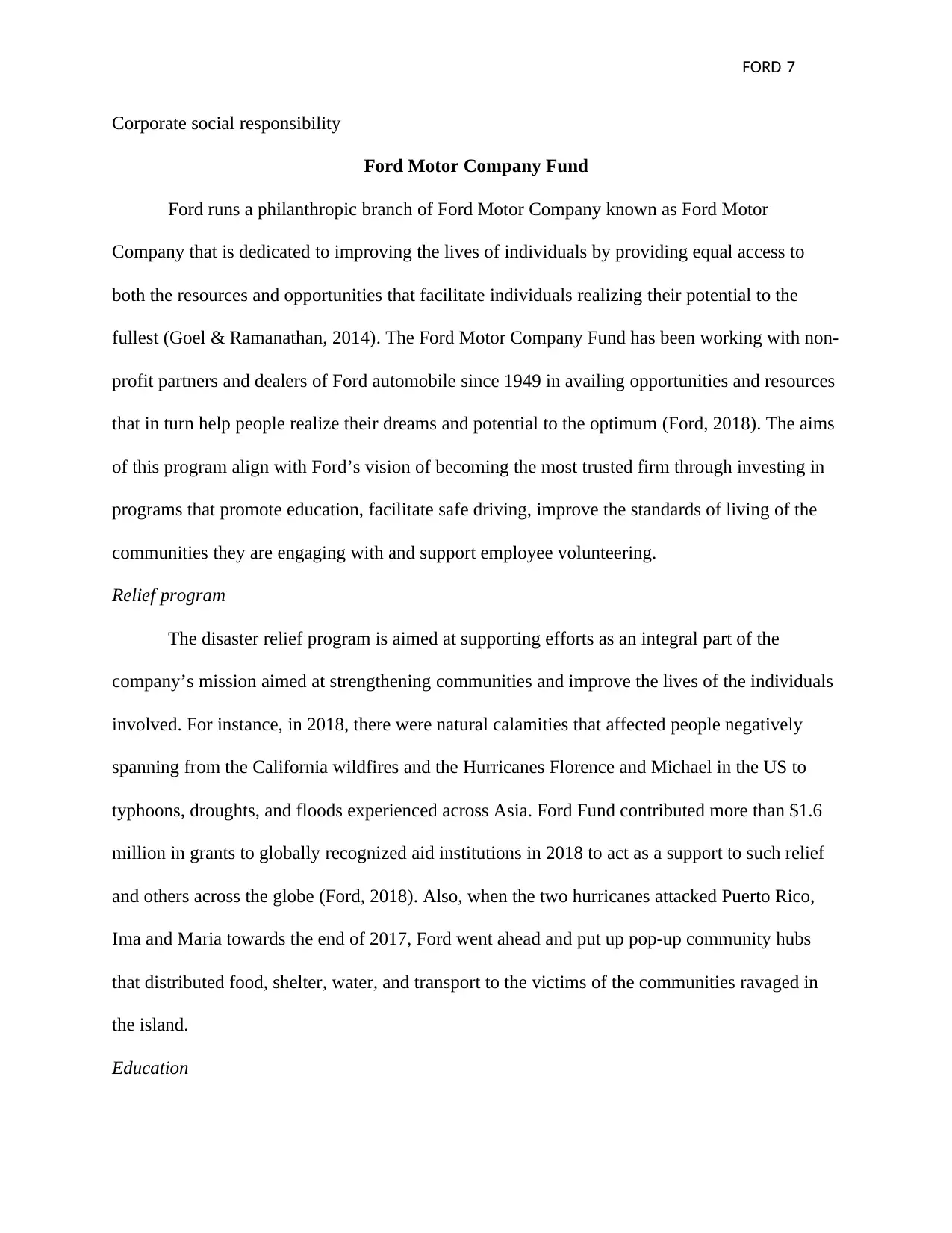
FORD 7
Corporate social responsibility
Ford Motor Company Fund
Ford runs a philanthropic branch of Ford Motor Company known as Ford Motor
Company that is dedicated to improving the lives of individuals by providing equal access to
both the resources and opportunities that facilitate individuals realizing their potential to the
fullest (Goel & Ramanathan, 2014). The Ford Motor Company Fund has been working with non-
profit partners and dealers of Ford automobile since 1949 in availing opportunities and resources
that in turn help people realize their dreams and potential to the optimum (Ford, 2018). The aims
of this program align with Ford’s vision of becoming the most trusted firm through investing in
programs that promote education, facilitate safe driving, improve the standards of living of the
communities they are engaging with and support employee volunteering.
Relief program
The disaster relief program is aimed at supporting efforts as an integral part of the
company’s mission aimed at strengthening communities and improve the lives of the individuals
involved. For instance, in 2018, there were natural calamities that affected people negatively
spanning from the California wildfires and the Hurricanes Florence and Michael in the US to
typhoons, droughts, and floods experienced across Asia. Ford Fund contributed more than $1.6
million in grants to globally recognized aid institutions in 2018 to act as a support to such relief
and others across the globe (Ford, 2018). Also, when the two hurricanes attacked Puerto Rico,
Ima and Maria towards the end of 2017, Ford went ahead and put up pop-up community hubs
that distributed food, shelter, water, and transport to the victims of the communities ravaged in
the island.
Education
Corporate social responsibility
Ford Motor Company Fund
Ford runs a philanthropic branch of Ford Motor Company known as Ford Motor
Company that is dedicated to improving the lives of individuals by providing equal access to
both the resources and opportunities that facilitate individuals realizing their potential to the
fullest (Goel & Ramanathan, 2014). The Ford Motor Company Fund has been working with non-
profit partners and dealers of Ford automobile since 1949 in availing opportunities and resources
that in turn help people realize their dreams and potential to the optimum (Ford, 2018). The aims
of this program align with Ford’s vision of becoming the most trusted firm through investing in
programs that promote education, facilitate safe driving, improve the standards of living of the
communities they are engaging with and support employee volunteering.
Relief program
The disaster relief program is aimed at supporting efforts as an integral part of the
company’s mission aimed at strengthening communities and improve the lives of the individuals
involved. For instance, in 2018, there were natural calamities that affected people negatively
spanning from the California wildfires and the Hurricanes Florence and Michael in the US to
typhoons, droughts, and floods experienced across Asia. Ford Fund contributed more than $1.6
million in grants to globally recognized aid institutions in 2018 to act as a support to such relief
and others across the globe (Ford, 2018). Also, when the two hurricanes attacked Puerto Rico,
Ima and Maria towards the end of 2017, Ford went ahead and put up pop-up community hubs
that distributed food, shelter, water, and transport to the victims of the communities ravaged in
the island.
Education
Paraphrase This Document
Need a fresh take? Get an instant paraphrase of this document with our AI Paraphraser
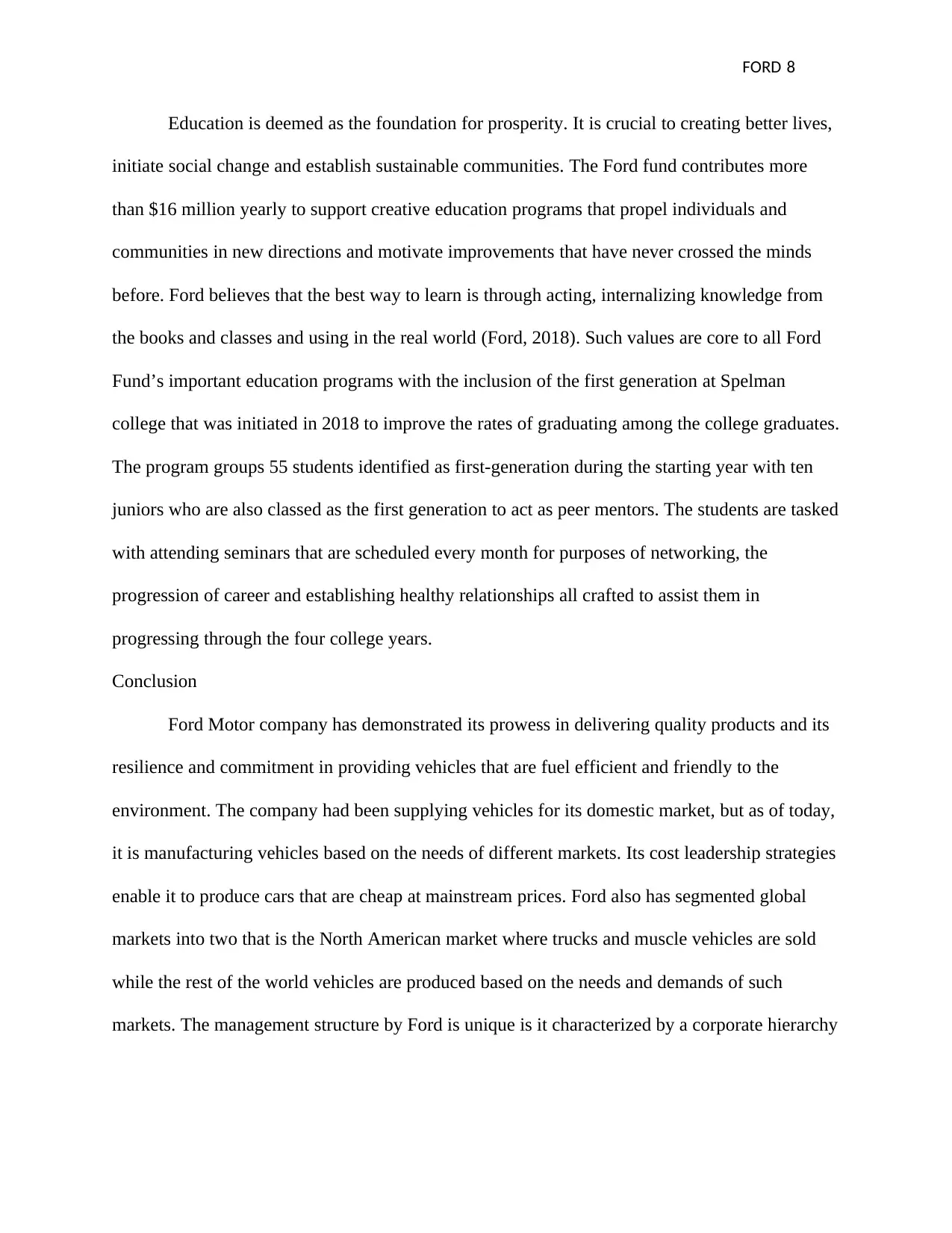
FORD 8
Education is deemed as the foundation for prosperity. It is crucial to creating better lives,
initiate social change and establish sustainable communities. The Ford fund contributes more
than $16 million yearly to support creative education programs that propel individuals and
communities in new directions and motivate improvements that have never crossed the minds
before. Ford believes that the best way to learn is through acting, internalizing knowledge from
the books and classes and using in the real world (Ford, 2018). Such values are core to all Ford
Fund’s important education programs with the inclusion of the first generation at Spelman
college that was initiated in 2018 to improve the rates of graduating among the college graduates.
The program groups 55 students identified as first-generation during the starting year with ten
juniors who are also classed as the first generation to act as peer mentors. The students are tasked
with attending seminars that are scheduled every month for purposes of networking, the
progression of career and establishing healthy relationships all crafted to assist them in
progressing through the four college years.
Conclusion
Ford Motor company has demonstrated its prowess in delivering quality products and its
resilience and commitment in providing vehicles that are fuel efficient and friendly to the
environment. The company had been supplying vehicles for its domestic market, but as of today,
it is manufacturing vehicles based on the needs of different markets. Its cost leadership strategies
enable it to produce cars that are cheap at mainstream prices. Ford also has segmented global
markets into two that is the North American market where trucks and muscle vehicles are sold
while the rest of the world vehicles are produced based on the needs and demands of such
markets. The management structure by Ford is unique is it characterized by a corporate hierarchy
Education is deemed as the foundation for prosperity. It is crucial to creating better lives,
initiate social change and establish sustainable communities. The Ford fund contributes more
than $16 million yearly to support creative education programs that propel individuals and
communities in new directions and motivate improvements that have never crossed the minds
before. Ford believes that the best way to learn is through acting, internalizing knowledge from
the books and classes and using in the real world (Ford, 2018). Such values are core to all Ford
Fund’s important education programs with the inclusion of the first generation at Spelman
college that was initiated in 2018 to improve the rates of graduating among the college graduates.
The program groups 55 students identified as first-generation during the starting year with ten
juniors who are also classed as the first generation to act as peer mentors. The students are tasked
with attending seminars that are scheduled every month for purposes of networking, the
progression of career and establishing healthy relationships all crafted to assist them in
progressing through the four college years.
Conclusion
Ford Motor company has demonstrated its prowess in delivering quality products and its
resilience and commitment in providing vehicles that are fuel efficient and friendly to the
environment. The company had been supplying vehicles for its domestic market, but as of today,
it is manufacturing vehicles based on the needs of different markets. Its cost leadership strategies
enable it to produce cars that are cheap at mainstream prices. Ford also has segmented global
markets into two that is the North American market where trucks and muscle vehicles are sold
while the rest of the world vehicles are produced based on the needs and demands of such
markets. The management structure by Ford is unique is it characterized by a corporate hierarchy
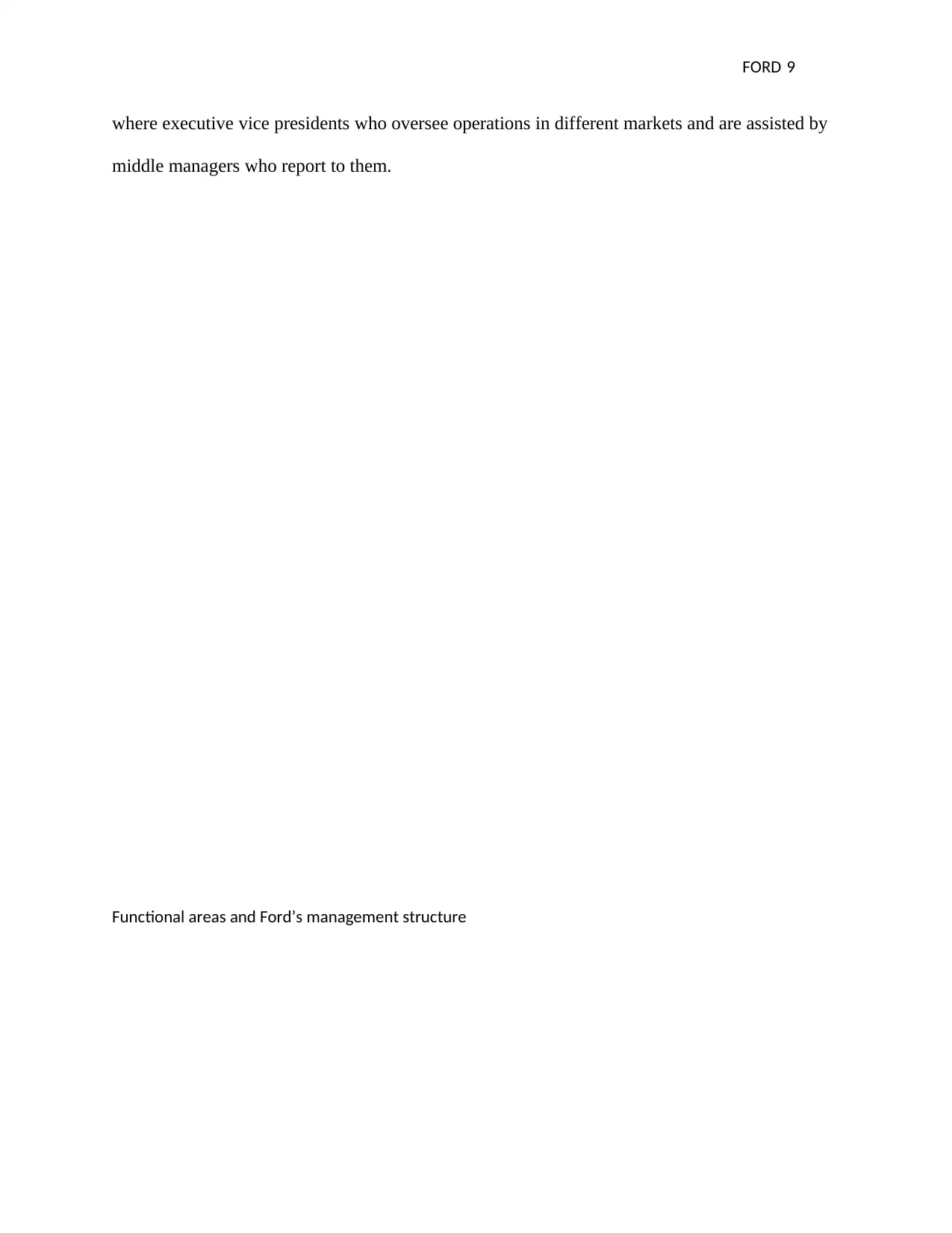
FORD 9
where executive vice presidents who oversee operations in different markets and are assisted by
middle managers who report to them.
Functional areas and Ford’s management structure
where executive vice presidents who oversee operations in different markets and are assisted by
middle managers who report to them.
Functional areas and Ford’s management structure
⊘ This is a preview!⊘
Do you want full access?
Subscribe today to unlock all pages.

Trusted by 1+ million students worldwide
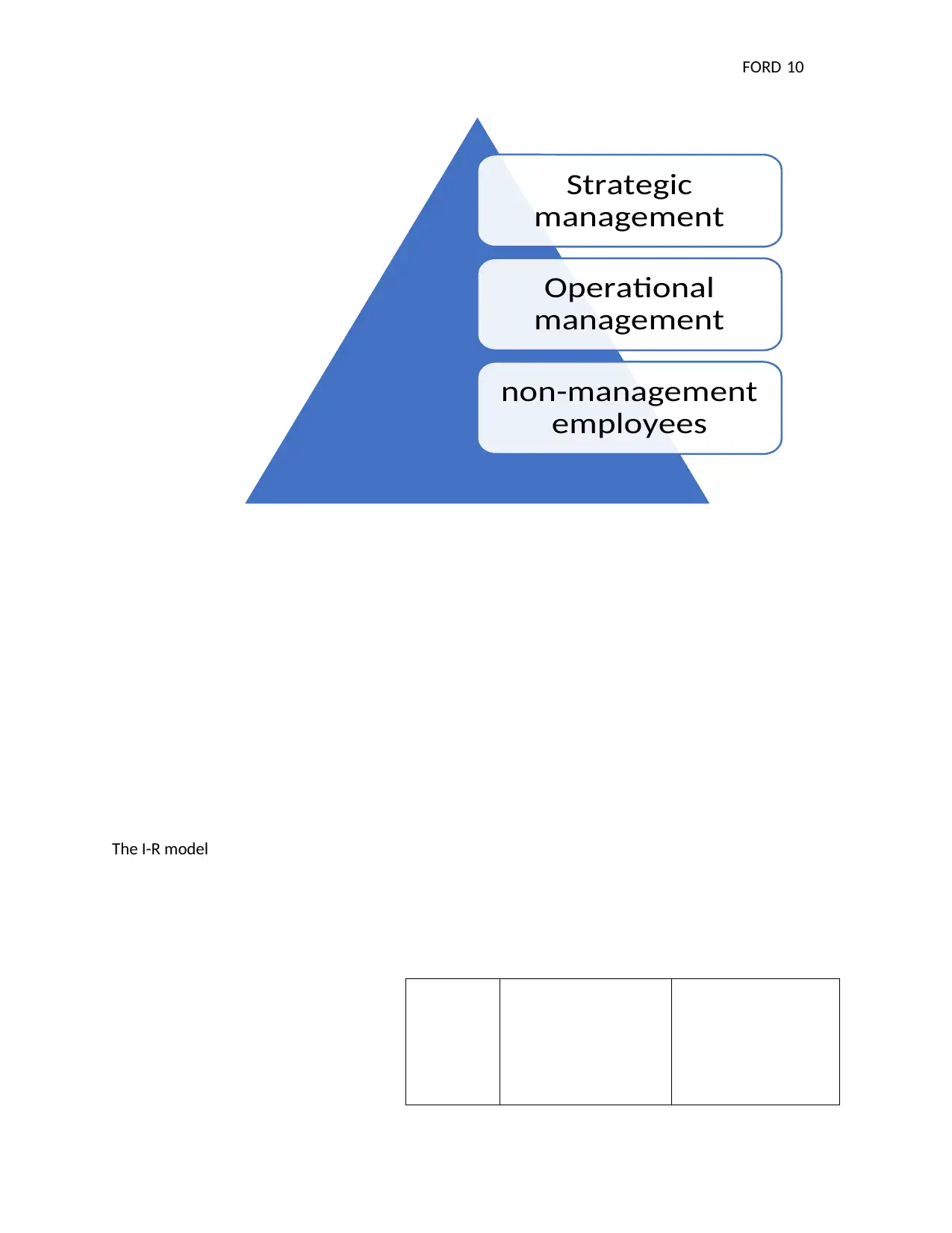
FORD 10
The I-R model
Strategic
management
Operational
management
non-management
employees
The I-R model
Strategic
management
Operational
management
non-management
employees
Paraphrase This Document
Need a fresh take? Get an instant paraphrase of this document with our AI Paraphraser
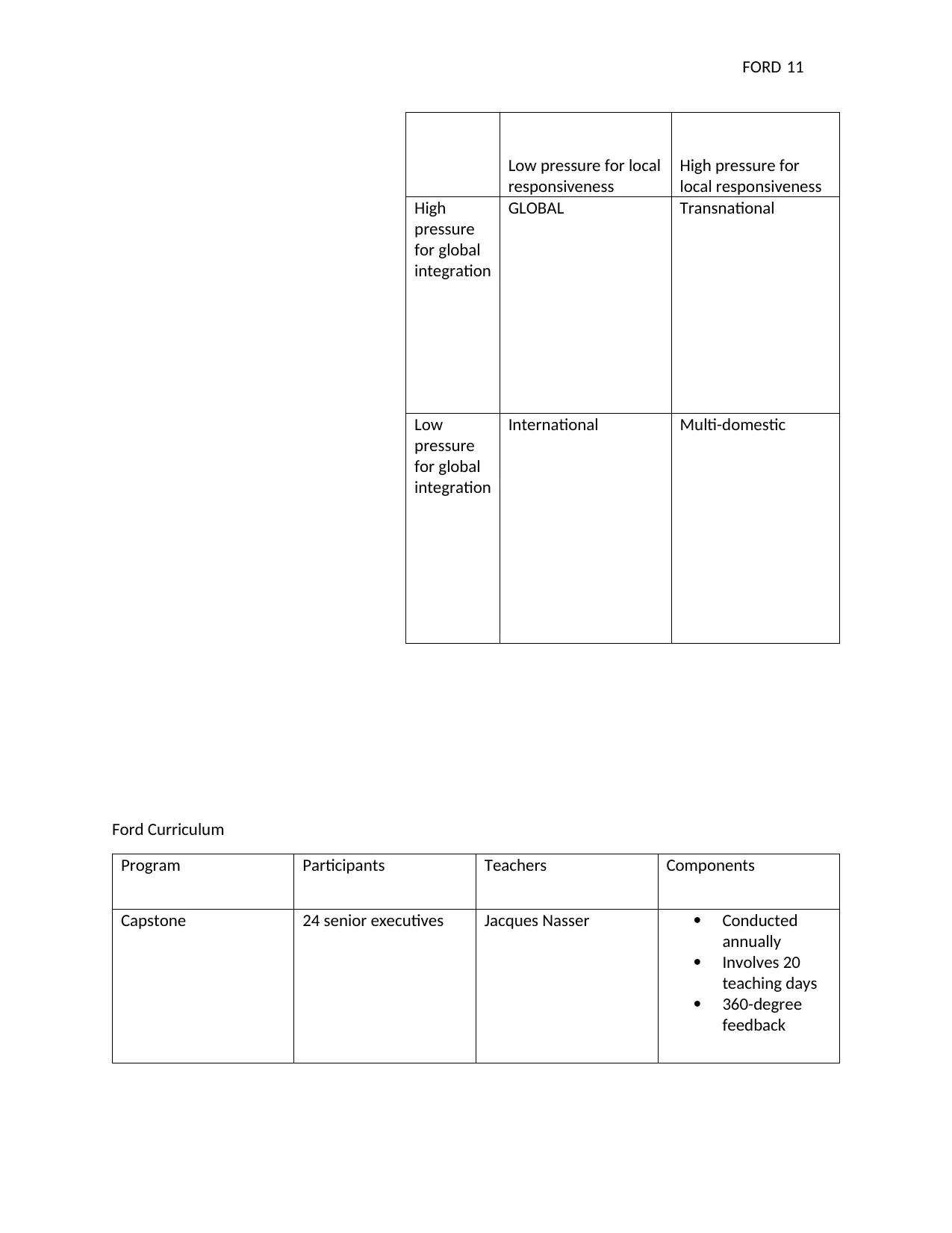
FORD 11
Low pressure for local
responsiveness
High pressure for
local responsiveness
High
pressure
for global
integration
GLOBAL Transnational
Low
pressure
for global
integration
International Multi-domestic
Ford Curriculum
Program Participants Teachers Components
Capstone 24 senior executives Jacques Nasser Conducted
annually
Involves 20
teaching days
360-degree
feedback
Low pressure for local
responsiveness
High pressure for
local responsiveness
High
pressure
for global
integration
GLOBAL Transnational
Low
pressure
for global
integration
International Multi-domestic
Ford Curriculum
Program Participants Teachers Components
Capstone 24 senior executives Jacques Nasser Conducted
annually
Involves 20
teaching days
360-degree
feedback
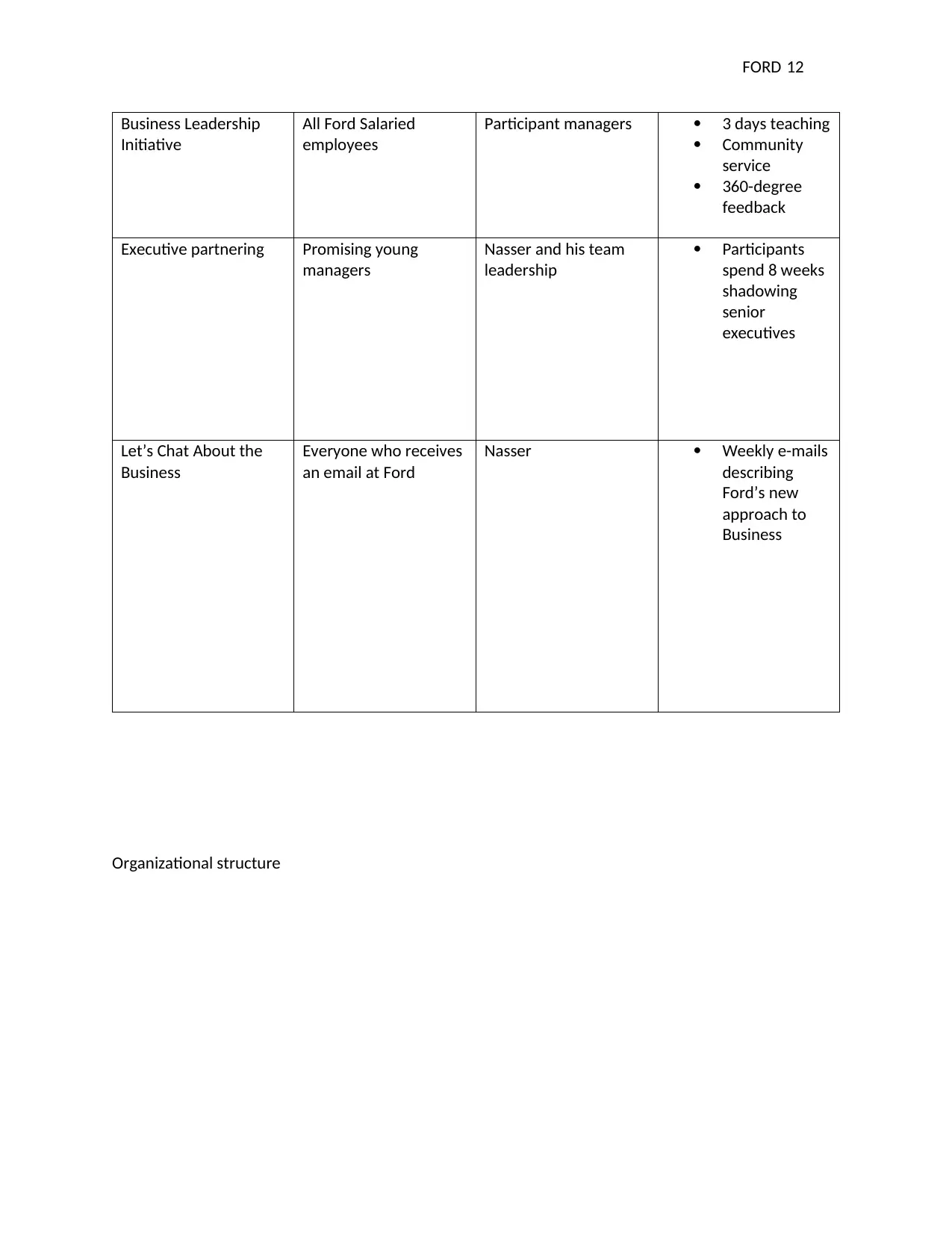
FORD 12
Business Leadership
Initiative
All Ford Salaried
employees
Participant managers 3 days teaching
Community
service
360-degree
feedback
Executive partnering Promising young
managers
Nasser and his team
leadership
Participants
spend 8 weeks
shadowing
senior
executives
Let’s Chat About the
Business
Everyone who receives
an email at Ford
Nasser Weekly e-mails
describing
Ford’s new
approach to
Business
Organizational structure
Business Leadership
Initiative
All Ford Salaried
employees
Participant managers 3 days teaching
Community
service
360-degree
feedback
Executive partnering Promising young
managers
Nasser and his team
leadership
Participants
spend 8 weeks
shadowing
senior
executives
Let’s Chat About the
Business
Everyone who receives
an email at Ford
Nasser Weekly e-mails
describing
Ford’s new
approach to
Business
Organizational structure
⊘ This is a preview!⊘
Do you want full access?
Subscribe today to unlock all pages.

Trusted by 1+ million students worldwide
1 out of 18
Related Documents
Your All-in-One AI-Powered Toolkit for Academic Success.
+13062052269
info@desklib.com
Available 24*7 on WhatsApp / Email
![[object Object]](/_next/static/media/star-bottom.7253800d.svg)
Unlock your academic potential
Copyright © 2020–2025 A2Z Services. All Rights Reserved. Developed and managed by ZUCOL.





